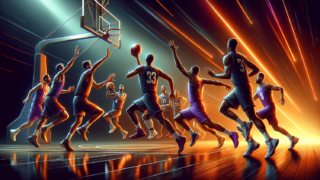
Ever wondered how basketball players can make a quick and unexpected long-distance pass that somehow reminds you of another iconic American sport? In the dynamic world of basketball, creativity and innovation collide, introducing unique plays like the baseball pass. Unwrap with us the mystique surrounding this exciting move in our latest blog post ‘What’s a Baseball Pass in Basketball?’. Get ready to dive through the simplicity and efficiency of this technique, where the fast-paced court action meets the charm of – you guessed it – baseball! Join us on this thrilling journey as we explore the mechanics, tips, and legendary moments of the baseball pass in basketball. Aim, throw, and make a buzzer-beating score with your newly acquired knowledge!
What’s a Baseball Pass in Basketball?
A baseball pass in basketball is a type of quick, long-distance pass that resembles a baseball throw. It involves a player using one arm to make an overhead pass across the court, generating significant speed and power. The aim is to swiftly move the ball to a teammate in a favorable position to score or beat defensive pressure. The baseball pass is often employed during fast breaks, end-of-game situations, or to catch the opposing team off-guard. Its effectiveness relies on precision, timing, and a thorough understanding of the game’s dynamics.
Unveiling the Mechanics of a Baseball Pass
Before we dive deeper into the world of baseball passes in basketball, it’s important to learn about its core mechanics. Mastering these elements not only comes with practice but also with a strong understanding of the fundamentals. Let’s take a closer look at the key components that make a successful baseball pass in basketball.
Proper Grip and Hand Positioning
Similar to how a baseball player grips a baseball, the grip in a baseball pass is crucial for executing an accurate and powerful throw. Hold the basketball with the throwing hand placed under the ball to form a claw grip. Your palm should not touch the ball, as the fingertips provide stability and control during the throw. Using this grip, placement of the index finger and middle finger toward the back of the ball allows for better control and precision in the pass.
Body Stance and Footwork
Footwork and body positioning play vital roles in the power and accuracy of a baseball pass. Start with your feet shoulder-width apart and your body facing your intended target. Your front foot should point at the intended target, while your back foot remains parallel to it. Take a comfortable stride forward, transferring your weight from the back foot to the front foot. This motion builds momentum and generates power behind the pass.
The Throwing Motion
The throwing motion in a baseball pass is slightly different from an actual baseball throw. Begin by extending the throwing arm fully backward, keeping your elbow slightly bent. As you perform the throwing motion, engage your core muscles and rotate your shoulder, whipping your arm forward into a straight-arm position. Ensure a proper follow-through, as the fingers of your throwing hand continue pointing at your target, allowing for a better trajectory and precision.
Essential Tips for Perfecting the Baseball Pass
Now that you have an understanding of the core mechanics of a baseball pass, there’s always more to learn when aiming for perfection. Here are some essential tips and best practices to implement when training your baseball pass in basketball.
Practice Your Grip
Consistency in grip is essential for mastering the baseball pass. Start by throwing the ball to yourself, focusing on maintaining control and the feel of the ball. Once you have a firm grip on the ball, try practicing the pass against a wall, paying attention to the consistency of your grip.
Work on Your Follow-through
A good follow-through is key to the accuracy and precision of your baseball pass. Work on finishing your throw with your arm and fingers pointing at the target, ensuring the appropriate trajectory for the pass. Practice using a target, such as a hoop or a marked spot on a wall, to gauge the accuracy of your follow-through.
Develop Timing and Anticipation
In order to execute a perfect baseball pass in basketball, you need to develop excellent anticipation and timing. This skill comes with experience, so don’t be afraid to experiment during practice games or scrimmages. Over time, you will learn to read your teammates’ movements and predict the actions of your opponents, allowing you to take advantage of openings on the court and execute a well-timed baseball pass.
Legendary Moments of the Baseball Pass in Basketball
Throughout the history of basketball, numerous memorable moments have showcased the power and magic of the baseball pass. Let’s take a trip down memory lane and revisit some of the greatest baseball passes that left fans in awe.
The Infamous Kevin Love to LeBron James Pass
One of the most iconic baseball passes in the history of the NBA came from Kevin Love, who hails from a family with a rich baseball history. During a game against the New York Knicks in 2015, Love seized an opportunity and executed a jaw-dropping one-handed, full-court pass to LeBron James. LeBron caught the ball in stride and scored an easy layup, leaving spectators amazed by the incredible display of skill and teamwork.
Magic Johnson and the Art of the Baseball Pass
Legendary player Magic Johnson was known for his top-tier passing skills, and he was no stranger to the baseball pass. Johnson had a unique ability to throw a precise, lightning-fast pass to his teammates, exploiting gaps in the opposing team’s defense. His extraordinary court vision and quick decision-making led to several game-changing moments throughout his illustrious career.
Steve Nash’s Game-Changing Pass against the Clippers
Steve Nash, a renowned point guard and playmaker, provided his own special moment with a baseball pass during a game against the Los Angeles Clippers in 2006. Nash caught a rebound with his non-dominant left hand, quickly shifted the ball to his right hand, and executed a perfect baseball pass down the court to teammate Leandro Barbosa. This play not only highlighted Nash’s incredible skill but also demonstrated his ability to switch hands seamlessly and maintain control under pressure.
Incorporating the Baseball Pass in Your Basketball Game
Now that you understand the fundamentals, tips, and the rich history of the baseball pass, it’s time to make this skill your own on the basketball court. Here are some effective ways to integrate the baseball pass into your game and make a noticeable impact.
Exploit Fast Break Opportunities
One of the best times to use a baseball pass is during a fast break. If you can snatch a defensive rebound or steal and spot a teammate streaking down the court, a well-executed baseball pass can cover a lot of ground quickly, leading to an easy scoring opportunity. Make sure you practice this skill in fast-paced, transition-oriented drills to get a feel for it under game conditions.
Surprise Your Opponents
The element of surprise can be a game-changer when it comes to using the baseball pass. If you can catch your opponent off guard, there is a higher chance of successfully completing the pass and creating an easy scoring chance. To do this, work on varying the speed, direction, and height of your pass during practice, as well as your court awareness and decision-making.
Develop Strong Team Chemistry
A successful baseball pass relies not only on the passer but also on the receiver. Team chemistry plays an essential role in anticipating and predicting each other’s movements on the court. Spend time practicing with your teammates to develop a shared understanding of each other’s strengths, weaknesses, and tendencies, as well as communication – both verbal and non-verbal.
Common Mistakes and How to Avoid Them
As with any skill in basketball, there are potential pitfalls that could hinder the effectiveness of your baseball pass. By identifying these common mistakes, you can take proactive steps to ensure a smooth and efficient pass – every time.
Overcommitting to the Pass
While it’s important to generate power behind your baseball pass, overcommitting can lead to a loss of control and accuracy. This can result in an errant pass or even a turnover. To avoid overcommitting, focus on building a strong foundation in footwork and balance, as well as controlling the force generated during the throw. Gradually increase the power behind your pass until you find the optimal balance between strength and control.
Poor Court Vision
Effective execution of the baseball pass requires excellent court vision, allowing the passer to identify openings and predict teammate positioning. If your court vision is lacking, it may lead to poorly timed passes and turnovers. To improve your court vision, use drills that challenge your peripheral awareness and spatial skills, such as multi-ball passing exercises, full-court scrimmages, and vision training games.
Neglecting the Receiver’s Role
While it’s natural to place significant emphasis on the execution of the pass itself, it’s important not to neglect the role of the receiver in a baseball pass. A perfect pass can fall apart if the receiver isn’t prepared to catch it. To avoid this, work on your team’s communication and timing, ensuring that both the passer and receiver are on the same wavelength during a baseball pass scenario. Practice catching drills, focusing on recognition and reaction skills, to ensure your teammates are well-prepared to receive your pinpoint passes.
Mastery of the baseball pass in basketball requires a firm grasp of the fundamentals, attention to detail, practice, and a strong team dynamic. By incorporating the techniques, tips, and knowledge shared in this blog post, you’ll bring an exciting and unconventional element to your game that can catch opponents off guard and create thrilling moments on the court. Remember, practice makes perfect, so get out there and start honing your baseball pass skills today!
Enhancing the Baseball Pass with Strength and Flexibility
When aiming to improve your baseball pass in basketball, incorporating specific strength and flexibility exercises into your training program can yield significant benefits. By focusing on the body movements and muscle groups utilized during a baseball pass, the improvements in your overall performance can be exceptional.
Upper Body Strength
Developing upper body strength, specifically in the shoulders, chest, and arms, is crucial for generating the power and control required for a precise baseball pass. Some exercises to include in your training regimen could be:
- Push-ups
- Overhead presses
- Dumbbell lateral raises
- Tricep extensions
- Medicine ball throws
These exercises can not only help you generate force behind your passes but also make them more accurate and consistent.
Core Stability and Power
The core plays a vital role in providing stability, balance, and power during the throwing motion of a baseball pass. Strengthening your core muscles can lead to improved control and accuracy in your passes. Consider incorporating the following exercises into your workout routine:
- Planks
- Side planks
- Russian twists
- Leg raises
- Mountain climbers
These exercises can help you develop a solid foundation and effectively transfer power from your lower body to your upper body during the baseball pass motion.
Lower Body Strength and Flexibility
A solid foundation and flexible lower body are key components in generating power and maintaining balance during a baseball pass. By focusing on exercises that target your lower body, you can enhance your overall performance on the basketball court. These exercises include:
- Squats
- Lunges
- Deadlifts
- Box jumps
- Hamstring curls
- Dynamic stretching
In addition to providing power and stability, these exercises can improve your overall athleticism, making you a more formidable player on the court.
Mastering the Baseball Pass in Different Game Situations
While you have already gained a deep understanding of the baseball pass, it’s essential to remain adaptable and prepared for various game situations that may require a swift adjustment. Let’s take a look at how the baseball pass can come into play during different scenarios in a basketball game.
End-of-Quarter or End-of-Game Situations
The baseball pass is uniquely suited for end-of-quarter or end-of-game situations where time is of the essence. In these scenarios, a well-timed baseball pass can create a quick scoring opportunity, change the momentum of the game, or even secure a victory. Practice the baseball pass during mock high-pressure situations to ensure you can effectively execute the pass when it matters most.
Beating Full-Court Pressure
Opposing teams may occasionally apply full-court pressure, attempting to create turnovers and disrupt your team’s offensive flow. The baseball pass can be a valuable weapon in breaking through full-court pressure, as its speed and range can catch the defense off-guard. Work on using the baseball pass to bypass full-court pressure, identifying mismatches and exploiting defensive weaknesses.
Utilizing the Baseball Pass in Inbounds Plays
While perhaps less common, a well-executed baseball pass can also come in handy during inbounds plays. This type of pass can catch the defense off-guard, quickly advancing the ball down the court and creating potential scoring opportunities. Develop strategies during practice that incorporate the baseball pass in your inbounds plays, enhancing your overall offensive arsenal.
By mastering the baseball pass in these different game situations, you can add a versatile and powerful tool to your basketball skillset, giving you an edge over the competition.
FAQ Section: Exploring the Baseball Pass in Basketball
In this FAQ section, we’ll address some common questions basketball enthusiasts might have about the baseball pass. From its origins to strategies and pitfalls, we’ve got you covered with everything you need to know about this unique and powerful pass.
1. Where did the baseball pass originate?
The baseball pass in basketball likely originated from players who had experience playing baseball or had been influenced by baseball throwing techniques. The pass utilizes the same principles of speed, power, and accuracy as baseball throws, adapted for use on the basketball court.
2. Is the baseball pass suitable for beginners?
Yes, the baseball pass can be suitable for beginners, provided they learn and focus on proper technique and execution. As with any skill in basketball, practice is key to mastering the baseball pass and incorporating it effectively into one’s game.
3. How can I improve the accuracy of my baseball pass?
To improve the accuracy of your baseball pass, focus on perfecting your grip, follow-through, body positioning, and footwork. Additionally, practice consistently with targeted drills, such as aiming for a hoop or a marked spot on a wall, to fine-tune your throwing motion and trajectory.
4. When should I use the baseball pass in a game?
Some ideal situations for using the baseball pass include fast breaks, end-of-quarter or end-of-game scenarios, breaking full-court pressure, or in carefully designed inbounds plays. Be aware of your teammates’ positioning and the opposing team’s defensive formation to find the right opportunities for using the baseball pass.
5. Can a baseball pass lead to traveling violations?
A baseball pass itself is unlikely to lead to traveling violations, as the passer will typically be stationary or maintain proper footwork during the pass. However, the receiver must be careful to avoid traveling after catching the pass by establishing a pivot foot or putting the ball on the floor immediately.
6. What strength training exercises should I focus on to improve my baseball pass?
To enhance your baseball pass, incorporate exercises that target the upper body, core, and lower body. Some examples include push-ups, overhead presses, planks, Russian twists, squats, lunges, and deadlifts. These exercises help build strength, balance, and flexibility across the muscle groups involved in the baseball pass motion.
7. How can I prevent turnovers when using the baseball pass?
To minimize turnovers when using the baseball pass, ensure solid communication and timing between the passer and receiver, perfect your grip and follow-through, work on anticipating teammate and opponent movements, and maintain strong court awareness.
8. Can a basketball player use a baseball pass with either hand?
While some players may use a baseball pass with either hand, it’s more common for them to favor their dominant hand for better control and power. However, ambidextrous players or those who train extensively can develop the ability to execute a baseball pass with both hands.
9. How long does it take to master the baseball pass?
The time it takes to master the baseball pass varies depending on the individual’s innate capabilities, training habits, and experience level. Consistent practice, dedication, and refinement of technique can greatly expedite the learning process.
10. What are common mistakes players make when executing a baseball pass?
Common mistakes during a baseball pass include overcommitting to the pass and losing control, poor court vision or anticipation, neglecting the receiver’s role, and improperly gripping the ball. Addressing these issues during practice can help improve the overall quality and effectiveness of your baseball pass.
11. How do I develop chemistry with my teammates for better baseball passes?
Developing strong team chemistry requires practice, communication, and building familiarity with each other’s strengths, weaknesses, and tendencies. Participate in team drills, scrimmages, and half-court and full-court scenarios to grow a deeper understanding of how your teammates move and react on the court.
12. What should I do if my opponent anticipates my baseball pass?
If your opponent anticipates your baseball pass, it’s essential to have alternative options in your arsenal. Work on disguising your intentions, utilizing a variety of passing techniques, and incorporating misdirection or decoy strategies to keep the defense guessing.
13. Are there basketball or NBA players known for their baseball pass skills?
Several basketball players and NBA legends have showcased their skill with the baseball pass, including Kevin Love, Magic Johnson, and Steve Nash. These players have each delivered memorable baseball passes in various game situations, demonstrating their exceptional court vision and throwing abilities.
Featured Posts
- No pillar pages found.




